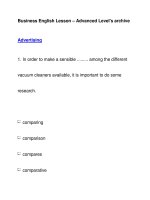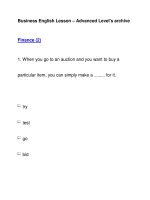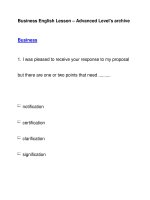spark english lesson, slide
Bạn đang xem bản rút gọn của tài liệu. Xem và tải ngay bản đầy đủ của tài liệu tại đây (673.72 KB, 42 trang )
Spark
Fast, Interactive, Language-Integrated
Cluster Computing
Wen Zhiguang
2012.11.20
Project Goals
Extend the MapReduce model to better support tw
o common classes of analytics apps:
>> Iterative algorithms (machine learning, graph)
>> Interactive data mining
Enhance programmability:
>> Integrate into Scala programming language
>> Allow interactive use from Scala interpreter
Background
Most current cluster programming models are b
ased on directed acyclic data flow from stable st
orage to stable storage
Benefits of data flow: runtime can decide
where to run tasks and can automatically
recover from failures
Background
Acyclic data flow is inefficient for applications t
hat repeatedly reuse a working set of data:
>> Iterative algorithms (machine learning, graphs)
>> Interactive data mining tools (R, Excel, Python)
With current frameworks, apps reload data fro
m stable storage on each query
Solution: Resilient
Distributed Datasets (RDDs)
Allow apps to keep working sets in memory for efficie
nt reuse
Retain the attractive properties of MapReduce
>> Fault tolerance, data locality, scalability
Support a wide range of application
Outline
•
Introduction to Scala & functional programming
•
What is Spark
•
Resilient Distributed Datasets (RDDs)
•
Implementation
•
Demo
•
Conclusion
About Scala
High-level language for JVM
>> Object-oriented + Functional programming (FP)
Statically typed
>> Comparable in speed to Java
>> no need to write types due to type inference
Interoperates with Java
>> Can use any Java class, inherit from it, etc;
>> Can also call Scala code from Java
Quick Tour
Quick Tour
All of these leave the list unchanged (List is Immutable)
•
Introduction to Scala & functional programming
•
What is Spark
•
Resilient Distributed Datasets (RDDs)
•
Implementation
•
Demo
•
Conclusion
Spark Overview
Concept: resilient distributed datasets (RDDs)
>> Immutable collections of objects spread across a cluster
>> Built through parallel transformations (map, filter, etc)
>> Automatically rebuilt on failure
>> Controllable persistence (e.g. caching in RAM) for reuse
>> Shared variables that can be used in parallel operations
Goal: work with distributed collections as you
would with local ones
Spark framework
Spark + Hive
Spark + Pregel
Run Spark
Spark runs as a library in your program
(1 instance per app)
Runs tasks locally or on Mesos
>> new SparkContext ( masterUrl, jobname,
[sparkhome], [jars] )
>> MASTER=local[n] ./spark-shell
>> MASTER=HOST:PORT ./spark-shell
Outline
•
Introduction to Scala & functional programming
•
What is Spark
•
Resilient Distributed Datasets (RDDs)
•
Implementation
•
Demo
•
Conclusion
RDD Abstraction
An RDD is a read-only , partitioned collection of records
Can only be created by :
(1) Data in stable storage
(2) Other RDDs (transformation , lineage)
An RDD has enough information about how it was derived from other da
tasets(its lineage)
Users can control two aspects of RDDs:
1) Persistence (in RAM, reuse)
2) Partitioning (hash, range, [<k, v>])
RDD Types: parallelized collections
By calling SparkContext’s parallelize method on an e
xisting Scala collection (a Seq obj)
Once created, the distributed dataset can be operat
ed on in parallel
RDD Types: Hadoop Datasets
Spark supports text files, SequenceFiles, and any
other Hadoop inputFormat
val distFiles = sc.textFile(URI)
Other Hadoop inputFormat
val distFile = sc.hadoopRDD(URI)
Local path or hdfs://, s3n://, kfs://
RDD Operations
Transformations
>> create a new dataset from an existing one
Actions
>> Return a value to the driver program
Transformations are lazy, they don’t compute right away.
Just remember the transformations applied to datasets(li
neage). Only compute when an action require.
Transformations
Transformations Meaning
map(func) Return a new distributed dataset formed
by passing each element of the source
through a function func
flatMap(func) Return a new datasets formed by
selecting those elements of the source on
which func returns true
union(otherDateset) Return a new dataset that contains the
union of the elements in the source
dataset and the argument
… …
Actions
Actions Meaning
reduce(func) Aggregate the elements of the dataset
using a function func
collect() Return all the elements of the dataset as
an array at the driver program
count() Return the number of elements in dataset
first() Return the first element of the dataset
saveAsTextFile(path)
…
Write the elements of the dataset as text
file (or set of text file) in a given dir in the
local file system, HDFS or any other
Hadoop-supported file system
……
Transformations & Actions
Representing RDDs
Challenge: choosing a representation for RDDs that can track lineage a
cross transformations
Each RDD include:
1) A set of partitions(atomic pieces of datasets)
2) A set of dependencies on parent RDDs
3) A function for computing the dataset based
its parents
4) Metadata about its partitioning scheme
5) Data placement









